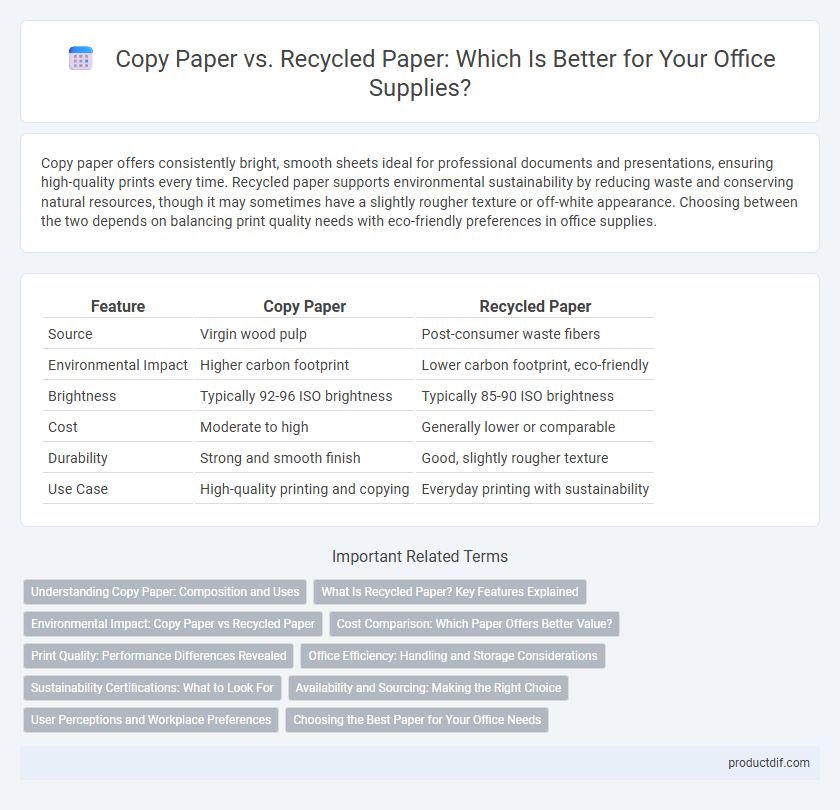Copy paper offers consistently bright, smooth sheets ideal for professional documents and presentations, ensuring high-quality prints every time. Recycled paper supports environmental sustainability by reducing waste and conserving natural resources, though it may sometimes have a slightly rougher texture or off-white appearance. Choosing between the two depends on balancing print quality needs with eco-friendly preferences in office supplies.
Table of Comparison
| Feature | Copy Paper | Recycled Paper |
|---|---|---|
| Source | Virgin wood pulp | Post-consumer waste fibers |
| Environmental Impact | Higher carbon footprint | Lower carbon footprint, eco-friendly |
| Brightness | Typically 92-96 ISO brightness | Typically 85-90 ISO brightness |
| Cost | Moderate to high | Generally lower or comparable |
| Durability | Strong and smooth finish | Good, slightly rougher texture |
| Use Case | High-quality printing and copying | Everyday printing with sustainability |
Understanding Copy Paper: Composition and Uses
Copy paper, typically made from virgin wood pulp, offers high brightness and smoothness ideal for inkjet and laser printers, ensuring sharp text and clear images. Recycled paper consists partly or entirely of post-consumer fibers, which may affect opacity and brightness but supports environmental sustainability. Understanding the composition differences helps businesses select paper that balances print quality with eco-friendly practices for various office tasks.
What Is Recycled Paper? Key Features Explained
Recycled paper is produced from post-consumer waste materials, reducing the need for virgin wood pulp and promoting environmental sustainability. Key features include lower energy consumption during manufacturing, reduced greenhouse gas emissions, and conservation of natural resources compared to traditional copy paper. It maintains comparable brightness and weight, making it suitable for everyday office printing and copying tasks while minimizing ecological impact.
Environmental Impact: Copy Paper vs Recycled Paper
Recycled paper significantly reduces environmental impact by conserving natural resources, lowering energy consumption, and minimizing landfill waste compared to conventional copy paper. Manufacturing recycled paper uses up to 60% less energy and reduces carbon emissions by nearly 45%, contributing to a smaller carbon footprint. Opting for recycled paper in office supplies supports sustainable forestry practices and decreases water usage, promoting overall environmental responsibility.
Cost Comparison: Which Paper Offers Better Value?
Copy paper typically costs less upfront than recycled paper but may have higher environmental disposal costs. Recycled paper often carries a slightly higher initial price due to the processing involved, yet it can reduce overall expenses linked to sustainability goals and waste management. Evaluating total cost of ownership, recycled paper offers better long-term value for businesses prioritizing eco-friendly office supplies.
Print Quality: Performance Differences Revealed
Copy paper typically delivers superior print quality with high brightness and smooth texture, ensuring sharp text and vibrant images. Recycled paper often contains fiber variations that can cause slight print inconsistencies, such as reduced sharpness and color fidelity. Advances in recycling technology are narrowing the performance gap, but original copy paper generally remains the preferred choice for professional-grade printing.
Office Efficiency: Handling and Storage Considerations
Copy paper typically offers smoother handling and consistent thickness, minimizing jamming in printers and copiers, which enhances office efficiency. Recycled paper, while eco-friendly, may have slight variations in texture and opacity that require more careful storage to prevent moisture absorption and curling. Proper storage in a climate-controlled environment preserves paper quality, ensuring consistent feed and reducing downtime in office workflows.
Sustainability Certifications: What to Look For
When choosing between copy paper and recycled paper, prioritize sustainability certifications such as FSC (Forest Stewardship Council) and PEFC (Programme for the Endorsement of Forest Certification) to ensure responsible forest management. Look for the Green Seal or EU Ecolabel logos, which indicate reduced environmental impact during production. Certifications like these guarantee that recycled paper meets rigorous environmental standards, supporting sustainable office practices while maintaining quality.
Availability and Sourcing: Making the Right Choice
Copy paper is widely available from numerous suppliers, offering consistent quality and a broad range of options suitable for high-volume office use, while recycled paper, sourced from post-consumer waste, supports sustainability but may have limited availability depending on regional recycling programs. Choosing the right paper depends on balancing the ease of procurement and the commitment to environmental responsibility, factoring in local supplier capacity and certification standards such as FSC or Green Seal. Office managers can optimize operations by selecting recycled paper from reputable vendors that ensure steady supply without compromising performance.
User Perceptions and Workplace Preferences
Users often perceive copy paper as offering superior whiteness and print clarity compared to recycled paper, influencing preferences for professional presentations and official documents. Workplace trends indicate a growing shift toward recycled paper driven by environmental sustainability goals, despite occasional concerns about paper durability and print quality. Organizations balance these preferences by selecting recycled papers with improved brightness and texture to meet both ecological commitments and functional requirements.
Choosing the Best Paper for Your Office Needs
Copy paper offers consistent brightness and smooth texture ideal for professional presentations and high-quality printing, while recycled paper supports environmental sustainability by reducing waste and conserving resources. Evaluate print volume, document type, and environmental goals to determine whether premium copy paper or eco-friendly recycled options best suit your office needs. Balancing cost efficiency with ecological impact ensures an optimal choice tailored to your company's values and operational demands.
Copy Paper vs Recycled Paper Infographic

 productdif.com
productdif.com